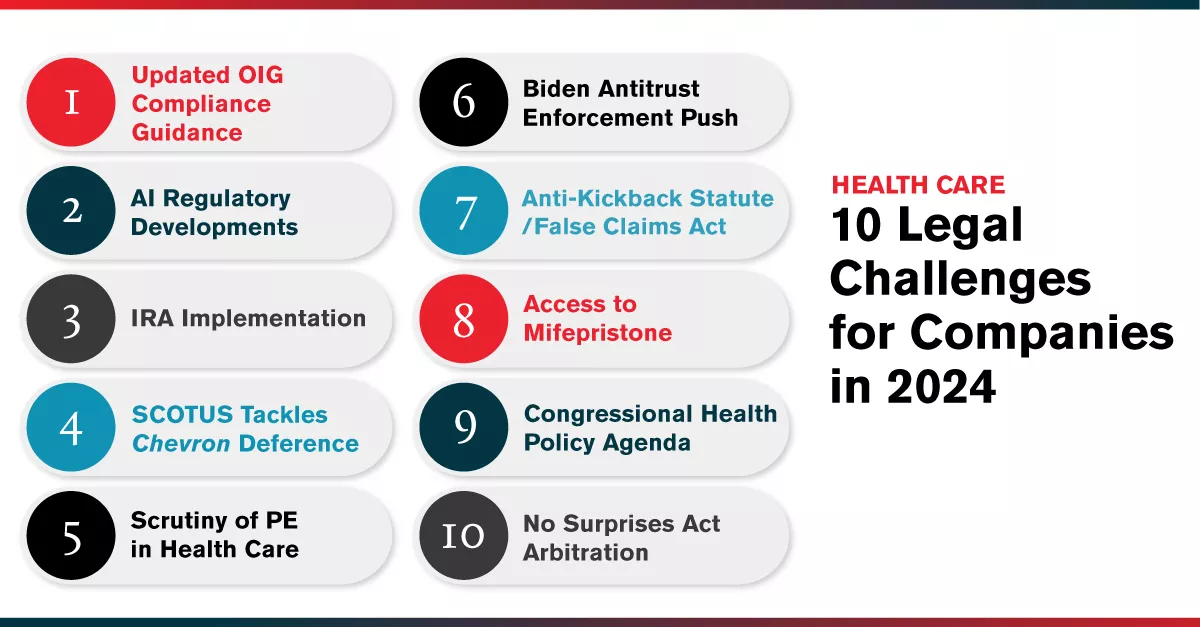10 Legal Challenges for the Health Care Industry in 2024
With 2024 underway, ArentFox Schiff highlights 10 of the most pressing legal issues facing the health care industry this year.

1. Updated Compliance Program Guidance from the OIG
In November 2023, the US Department of Health and Human Services (HHS) Office of the Inspector General (OIG) issued its first-ever general compliance program guidance (GCPG) applicable to all health care providers and suppliers. While the GCPG largely tracks guidance previously issued by the OIG (e.g., focusing on the framework of the seven elements of an effective compliance program), the GCPG includes additional details on the OIG’s specific expectations for how health care stakeholders can meet each element. For example, the GCPG includes a robust discussion of compliance leadership and oversight, including an emphasis on the role of the board of directors in overseeing an organization’s compliance program. The GCPG also describes common risk areas for health care stakeholders and emphasizes the importance of monitoring the regulatory and legal landscape (e.g., enforcement actions and OIG workplan audits and results) to assess developing risk areas that could impact health care organizations.
Additionally, the OIG provided guidance on adapting the “seven elements” framework to smaller entities and instructions for new entrants into the health care sector, including technology companies, private equity investors, and non-traditional service providers, such as social service, food delivery, and care coordination services providers. Moreover, the OIG noted that new entrants into health care are often unfamiliar with the unique regulatory landscape appliable to the health care industry, increasing the risk they could violate the law. While the GCPG is voluntary, the detailed guidance document sets forth the OIG’s expectations for all entities involved in health care, including those in the technology and private equity space. For 2024, the OIG expected to begin issuing industry-specific compliance program guidance aimed at addressing industry-specific risk areas. This forthcoming guidance will replace current industry-specific guidance, some of which has not been updated by the OIG in more than 20 years. Those in the health care sector should use the GCPG to assess their current compliance programs and identify areas where revisions to the programs may be necessary and stay on the lookout for additional industry-specific guidance in 2024.
2. Significant AI Regulatory Developments in Health Care
2023 was a year of tremendous growth and visibility for artificial intelligence (AI) systems and tools. This growth has led to increasing calls for regulation and oversight. We expect 2024 to be a year in which those calls are answered with some specificity by lawmakers and regulators. The Bipartisan Framework was introduced on September 12, 2023, which established five key recommendations for regulating AI models. Though not specific to the health care industry, the framework offers helpful guidance for developers of AI systems. More recently, the Biden Administration’s October 30, 2023 Executive Order on the on the Safe, Secure, and Trustworthy Development and Use of AI (the Order) addressed the use of AI in health care and the safety and integrity of data stored and generated by AI health care technology systems. The Order directed HHS to establish an AI Task Force (Task Force) that must, within 365 days of its creation, develop policies and specific frameworks addressing the use of AI and AI-enabled technologies in the health sector, including research, drug and device safety, and health care delivery and financing. The Task Force is to identify resources and provide guidance that focuses on predictive and generative AI technologies, safety and performance monitoring of AI technologies, safety and integrity of documentation, and privacy and security standards. We expect HHS, through the Task Force, to publish the frameworks and policies in 2024. ArentFox Schiff will continue to monitor these developments.
3. IRA Implementation Stuck in Federal Courts
The Inflation Reduction Act (IRA) was passed into law on August 16, 2022. The drug pricing reform sections of the IRA bring many changes to Medicare coverage and reimbursement for prescription drugs. The hallmark of the law is that, for the first time, the Centers for Medicare & Medicaid Services (CMS) may directly negotiate reimbursement to be paid for a subset of drugs covered by Medicare Part D plans. While CMS is in the process of negotiating Maximum Fair Prices for more than 10 drugs for 2026 (here’s the list), stakeholders await court decisions pending in eight cases filed by manufacturers and industry groups in multiple federal courts across the country that are challenging the negotiation provisions of the IRA as unconstitutional. As the negotiation provisions are central to the Part D redesign under the IRA, if those provisions are struck down as unconstitutional, what happens to the Part D benefit? Will plans leave the Part D marketplace if they are forced to pick up more of the financial responsibility for the Part D program absent lower negotiated drug prices? Even if sponsors do not leave the Part D marketplace, premiums will certainly rise if the IRA’s drug negotiation provisions are struck down. Stay tuned.
4. The Supreme Court Tackles Chevron Deference
Chevron deference is the principle that courts should defer to an agency’s reasonable interpretation of an ambiguous statute. Chevron deference tilts the scales toward interpretations and decisions made by federal agencies when agency regulations or decisions are challenged in court. The US Supreme Court held oral arguments in January 2024 in Loper Bright Enterprises v. Raimondo, a case involving fishery oversight by the National Marine Fisheries Service, addressing the issue of whether federal courts should continue to uphold Chevron and defer to agency decision-making as to whether a rulemaking is a reasonable interpretation of the law.
Early indications from oral arguments are that Chevron deference may be severely constrained or eliminated altogether by the Supreme Court. Consequently, if Chevron is overturned, agency rulemakings and administrative actions may be easier for parties to challenge if courts are no longer required to defer to the federal agency’s interpretation of a statute. This could have a significant impact on the health care industry, which is heavily regulated by multiple federal agencies and is subject to regular federal rulemakings concerning everything from health care operations and patient safety to reimbursement. Expect a decision in 2024.
5. Private Equity in Health Care Under Scrutiny
As private equity (PE) firms continue to experience tremendous growth in the health care sector, policymakers and regulators are asserting a greater oversight role. For instance, in September 2023, the Federal Trade Commission (FTC) filed a lawsuit against an anesthesia services provider and PE firm alleging that the parties “executed a multi-year anticompetitive scheme to consolidate anesthesiology practices in Texas, drive up the price of anesthesia services provided to Texas patients, and boost their own profits.” Animated by similar worries about the anticompetitive impacts of PE deals, numerous states, such as Illinois, enacted new laws that will subject certain health care transactions to state agency notice and approval requirements beginning in 2024. Regulators are also adopting transparency measures to gain insight into PE ownership and affiliation structures. For example, in November 2023, CMS published a final rule requiring Medicare- and Medicaid-participating nursing homes to disclose certain ownership, managerial, and other information, which CMS will make publicly available. CMS noted that the rule was prompted by concerns about the “quality of care at nursing homes, especially those owned by private equity companies and other types of investment firms.” As regulatory oversight and enforcement activities persist in 2024 on the federal and state levels, PE firms must remain attentive to the unique and evolving risks to ensure the viability and success of their investments.
6. Biden Administration Pushes Antitrust Enforcement in Health Industry
2024 promises to be another year of active enforcement of the antitrust laws in the health care sector, with a particular focus on the role corporations and PE ownership is playing in the industry. On December 7, 2023, the White House announced a new set of initiatives to promote competition in health care. One of those initiatives is “scrutinizing anticompetitive acquisitions and anticompetitive pricing,” which includes an effort by the US Department of Justice (DOJ), FTC, and HHS to solicit information through Requests for Information about how corporations and PE firms are allegedly adversely impacting the health care sector by maximizing profits at the expense of patients’ health and safety. DOJ, FTC, and HHS will also be looking at how PE firms, health insurers, and health systems are executing “roll up” strategies of relatively small acquisitions to lead to market consolidations, which have – to date – avoided ready review by antitrust enforcers. Expect that the information and data sharing gathered by these agencies will result in new investigations and cases filed by antitrust enforcers.
7. First Circuit to Enter the Anti-Kickback Statute/False Claims Act Causal Divide
In 2010, US Congress amended the Anti-Kickback Statute (AKS) to state that a claim to a federal health care program for reimbursement “resulting from” an AKS violation constitutes a false or fraudulent claim under the False Claims Act (FCA). However, there is a split among the US courts of appeal on the interpretation of “resulting from.” The Sixth and Eighth Circuits require proof that but for an illegal kickback, the government would not have paid a claim, while the Third Circuit requires evidence “that shows a link between the alleged kickbacks and the medical care received.” The issue is before the First Circuit as a result of two similar cases pending in the District of Massachusetts involving pharmaceutical companies. The companies argued that the government should have to prove that the claims to government programs would not have been made without the alleged kickbacks, whereas the government pushed for the Third Circuit’s less stringent standard. After two district court judges came to different conclusions regarding the proper standard, the First Circuit agreed to a rare mid-case appeal and will consider the question sometime in 2024, marking its entry into the AKS causal divide. ArentFox Schiff diligently monitors all litigation related to AKS and FCA liability to ensure our clients stay abreast of any changes in the legal landscape. Read our Investigations Blog.
8. US Supreme Court to Weigh in on Access to Mifepristone and Reproductive Health
In Alliance for Hippocratic Medicine v. FDA, a collection of organizations and providers that oppose abortion filed a lawsuit in Texas seeking a preliminary and permanent injunction ordering the US Food and Drug Administration (FDA) and HHS to withdraw FDA’s approval of Mifeprex, generic mifepristone, and misoprostol for use in the provision of abortion. Three months later, 12 states (subsequently joined by additional states and the District of Columbia) filed a concurrent suit in Washington state to enjoin FDA from taking any action to remove mifepristone from the market or reduce its availability (State of Washington v. FDA). Both district courts issued conflicting orders mere minutes apart in April 2023.
The Texas district court purported to “stay” the effective date of FDA’s 2000 approval of Mifeprex and all subsequent challenged FDA actions related to that approval, an action that would effectively render FDA’s Mifeprex and mifepristone approvals defunct. Meanwhile, the Washington district court preliminarily enjoined FDA from “altering the status quo and rights as it relates to the availability of [m]ifepristone” in the plaintiff states. The Fifth Circuit Court of Appeals ruled on the Texas district court order in August 2023, but both the Fifth Circuit and district court orders are subject to an April 2023 stay issued by the Supreme Court. In December 2023, the Supreme Court granted certiorari and agreed to review the Fifth Circuit’s decision and address FDA’s approval process as to mifepristone. This is a hotly contested issue from both a politically and an administrative law perspective that will be addressed by the Supreme Court in 2024. At this time, the outcome of both the Texas and Washington cases remains to be seen. The ArentFox Schiff Reproductive Health Task Force is closely tracking this litigation and will provide further updates as they come.
9. Congressional Health Policy Agenda
As the new year unfolds, there is good reason to question the ability of this polarized Congress to finalize the appropriations process for the fiscal year that started on October 1, 2023. There has been little forward progress in considering and passing the bill funding “discretionary” HHS programs, including the National Institutes of Health, health workforce, mental health/substance abuse, and the Centers for Disease Control & Prevention. On January 26, House and Senate appropriators finalized fiscal year 2024 subcommittee allocations, which is a positive development for finalization of all 12 appropriations bills. However, it remains possible Congress may pass a full year continuing resolution that would essentially freeze in place the prior fiscal year funding levels less a substantial cut mandated by the 2023 debt ceiling law, the Fiscal Responsibility Act. It remains to be seen whether US House Speaker Mike Johnson (R-LA) and the House Republican majority have the votes to support the Labor, Health and Human Services Appropriations bill if it fails to cut spending and leaves out numerous conservative policy riders. Consequently, House Republicans will either join with House Democrats to pass the final versions of the appropriations bills or they may not pass and the Congress will end up passing a full-year continuing resolution to keep the federal government funded. Apart from the dysfunction surrounding the annual appropriations process, there has been incremental progress related to health care policy legislation, including a House-passed bill to promote more transparency in health care pricing, reform some regulations related to pharmacy benefit managers, reduce some out-of-pocket costs for Medicare beneficiaries, and increase spending robustly on community health centers and various health workforce programs. The Senate HELP Committee and Finance Committee have been working hard on comparable bills, and it is quite possible that during 2024 we could see further movement on this kind of comprehensive health policy legislation.
10. Changes and Uncertainty in the No Surprises Act Arbitration Process
Health care providers continue to grapple with uncertainty and face an ever-changing regulatory landscape governing the independent dispute resolution (IDR) process under the federal No Surprises Act (NSA). The “baseball style” arbitration process was intended to resolve disputes between providers and payers efficiently as to appropriate out-of-network payment rates. Instead, implementation of the NSA has been subjected to numerous bumps in the road that have significantly delayed the resolution of disputes submitted for arbitration. Regulations governing what factors arbitrators should consider when reaching a decision – and what weight to assign those factors – were vacated by a federal district court not once but twice in lawsuits brought by provider groups, though the Biden Administration continues to appeal those decisions.
Subsequently, in August 2023, providers scored additional back-to-back victories over the Biden Administration. Although provider groups have achieved significant victories in striking rules and regulations that they argued improperly tilted the IDR process in favor of payers (such as the “batching” process for submission of claims, the increase in non-refundable administrative fees, and calculation standards for making qualified payment amounts), the vacatur of existing regulations has halted the NSA dispute resolution process on multiple occasions. For instance, the IDR submission portal has at various points in time been closed to some or all submissions, substantive rules and fees have changed, and the federal agencies with oversight of the IDR process have recently proposed lengthy new regulations addressing a variety of aspects of the IDR process challenged in federal court. While some of these regulations are currently in the notice-and-comment process, they will result in further changes in the IDR process in 2024 if implemented. ArentFox Schiff remains active both in provider litigation and in representing providers in the IDR process. To stay up to date, check out our No Surprise Act Analysis.
Contacts
- Related Industries
- Related Practices













